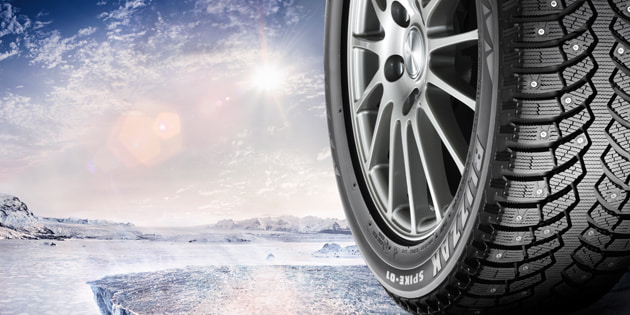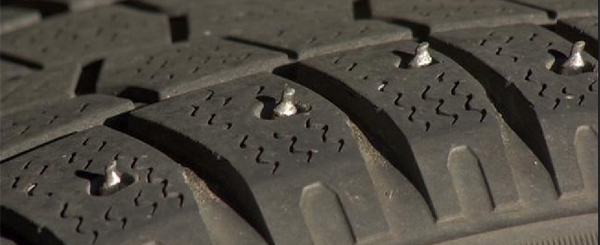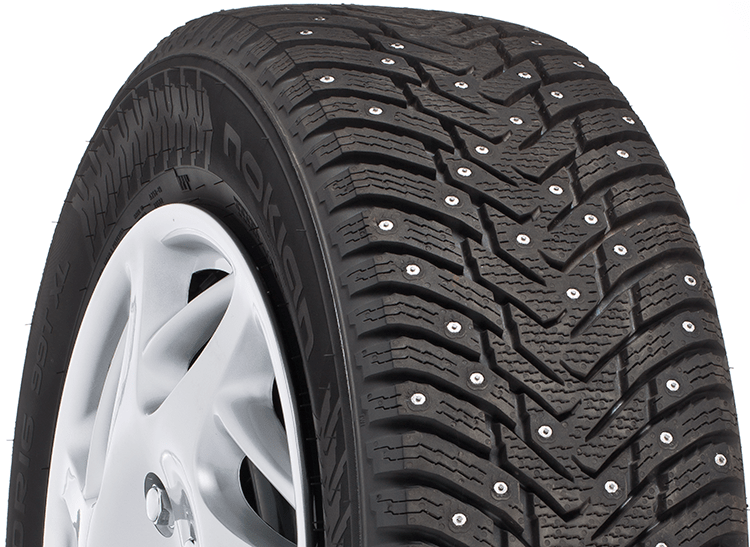Using Studded Winter Tires And What You Should Know About Them
Studded tires are tires where approximately 80 to 100 small metal studs are inserted to increase traction on the roads, particularly on icy or snowy surfaces. Although studded tires have been around since the 1890s, the use of studded tires in the United States was only introduced in the early 1960s.

Records show that the modern studded tires these days first gained popularity in Scandinavia in the 1950s. The popularity of using studded tires on the icy roads in northern Europe happened about two decades earlier before its popularity grew in the US. However, the benefit of providing more traction during winter time and the damage which studded tires cause on non-icy pavements remain as points of contentions during debates.
Its popularity in the US in the 1970s also prodded researchers to assess its safety and effects on the pavement. State governments and countries differ in their policies of allowing the use of studded winter tires. Two decades ago, Rune Elvik looked into the effects on accident of studded tires and laws banning its uses. Elvik presented his paper during the 77th Annual Meeting of the Transportation Research Board on January 11 to 15, 1998. In his study, he concluded that using studded tires only decreased the crash rate by a “quite small” rate of 1 to 10 percent.
However, most recent researches are looking into the future of innovating studded tires with retractable studs. A market study also painted a rosy forecast for the winter tire market with a projection of a growing global sales of winter tires 4.4 percent annually with a total value of $25 billion by 2021. Table 1 below shows the projected increasing demand for winter tires especially in countries with colder climates.
Table 1. Growing demand for winter tires (Source: Smithers Rapra)

Can you put studs on any tires?
Like regular tires, studded tires wear out, too. That is why you can only put studs on new tires that have never been used. You cannot put a stud nor re-stud tires which were already driven on because it might cause serious tire damage from incorrect stud lengths or debris that were trapped under the stud.
How studded tires work
The studs are made of an extremely hard metal called tungsten carbide which weighs between 1.7 to 1.9 grams each. The studs are inserted on the tire’s surface leaving a protrusion of about 1.2 to 1.5 mm from the tire’s surface.
The holes where the studs fit were molded into the tread when manufactured. If a stud is inserted incorrectly – either too shallow or too deep, it will not operate efficiently. For instance, when studs are inserted too deep, the protrusion will not reach the tread surface and will not effectively provide traction. On the other hand, when inserted too shallowly, the protrusion might wiggle and could enlarge the molded hole and be ejected.
The tire stud, when properly calibrated, could maintain its protrusion length even when studdable tires wear out. When the vehicle that uses studded tires ran on the ice, the studs will dig into the ice, increasing the traction.
What Makes Winter Tires Unique?
Studded tires are winter tires that are built to run on places where there is heavy snowfall making the road condition extremely unpredictable. The cold temperature challenges the tires’ traction capacity. Hence, winter tires were manufactured to provide tread rubber that remains flexible allowing it to get a grip of the road more efficiently. Therefore, if you are looking for tires with good grip, then you should pay attention to brands such as Nitto, which specialize in this characteristic in the production of their tires. Or choose tires from manufacturers that make winter tires, even used Nokian tires will be effective in this case.
The tread depths and patterns of winter tires are also deeper and more unique allowing the tire to reduce snow build up and get better traction over the snowy road. These types of tires also have high sipes density giving it more traction on ice.
Can I Use My Winter Tires All Year Round
Changing tires could be tiring or inconvenient. However, using winter tires all year round is not recommended since this will cost you a lot of money and will compromise your car’s performance on the road. Tire manufacturers made different types of tires for different seasons because each season, the road condition would need a special kind of vehicle to keep you safe on the road and sometimes you need to use the rugged terrain tires.
Winter tires tend to wear faster on a warm and dry pavement. Since the tread rubber of winter tires is made more flexible than other types of tires, warm temperatures can quickly wear them down. Unlike winter tires, summer and all-season tires are built to withstand warm weather. Using your winter tires in any season will also decrease its performance. Once it is already winter again, you may find your studded winter tires worn out.
When are Tire Studs Worn Out?

Tire studs wear out as they are driven on icy roads. The pins on studded winter tires wear a little slower than the metal casings around them retaining the stud’s efficiency to continue to run on an icy surface. But when a winter studded tire’s tread wears down to approximately 5/32”, the studs gradually lose effectiveness in running on deep snow. Studded winter tires are considered worn out when the tread depth is below six mm.
Here are some signs that will tell you when studded tires have worn out:
- Punctured tire. Any cut on your tire that measures 1/4” can be repaired by the mechanic. However, when you are on the road and can’t seem to contact any technician, swap your tire with the spare to prevent further damage on the tread.
- Lack of proper air pressure. The required air pressure should always be followed to avoid under-inflation or over-inflation that can damage your tire. The recommended tire pressure is indicated on the car manual.
- Bulbs or bulges. A bulge signals the need for replacement. Once a bulge appears on the surface, it indicates that the tire’s cords are damaged already.
Where are studded tires legal?
Countries all over the world differ on their demand for winter ties A few states allow the use of studded tires without any exemptions, some of them totally prohibit its use, while several states grant exemptions based on the weather conditions and studs that have reasonable proportions. Table 2 below shows the policy of each state on the use of studded winter tires:
Table 2. Differences of Policies on the Usage of Studded Tires Among Federal States (Source: www.ustires.org)
|
Laws by State |
| State | Legislation | |
| Alabama | Studded tires are prohibited. | |
| Alaska | North of 60° Latitude – Allowed from September 16th – April 30th. South of 60° Latitude – Allowed from October 1st – April 14th. | |
| Arizona | Studded tires are allowed from October 1st – May 1st. | |
| Arkansas | Studded tires are allowed from November 15th – April 15th. | |
| California | Studded tires are allowed from November 1st – April 30th. | |
| Colorado | Studded tires are allowed. | |
| Connecticut | Studded tires are allowed from November 15th – April 30th. | |
| Delaware | Studded tires are allowed from October 15th – April 15th. | |
| Florida | Metal-studded tires are prohibited. | |
| Georgia | Studded tires are prohibited unless required for safety because of snow, ice or other weather conditions that cause a vehicle to skid. | |
| Hawaii | Studded tires are prohibited. | |
| Idaho | Studded tires are allowed from October 1st – April 30th. | |
| Illinois | Studded tires are prohibited. Rural mail carriers and persons with disabilities living in unincorporated areas may use studs from November 15th – April 1st. | |
| Indiana | Studded tires are allowed from October 1st – May 1st. | |
| Iowa | Studded tires are allowed from November 1st – April 1st. | |
| Kansas | Studded tires are allowed from November 1st – April 1st. | |
| Kentucky | Studded tires are allowed. | |
| Louisiana | (Contact State Police for information at 225.925.6325) | |
| Maine | Studded tires are allowed from October 2nd – April 30th. | |
| Maryland | Studded tires are allowed from November 1st – March 31st for vehicles registered in Allegheny County, Carroll County, Frederick County, Garrett County and Washington County only. | |
| Massachusetts | Studded tires are allowed from November 1st – April 30th. | |
| Michigan | Studded tires are prohibited. | |
| Minnesota | Studded tires are prohibited. | |
| Mississippi | (Contact Public Safety at 601.987.1212) | |
| Missouri | Studded tires are allowed from November 1st – March 31st. | |
| Montana | Studded tires are allowed from October 1st – May 31st. | |
| Nebraska | Studded tires are allowed from November 1st – April 1st. | |
| Nevada | Studded tires are allowed from October 1st – April 30th. | |
| New Hampshire | Studded tires are allowed. | |
| New Jersey | Studded tires are allowed from November 15th – April 1st. | |
| New Mexico | Studded tires are allowed. | |
| New York | Studded tires are allowed from October 16th – April 30th. | |
| North Carolina | Studded tires are allowed. | |
| North Dakota | Studded tires are allowed from October 15th – April 15th. | |
| Ohio | Studded tires are allowed from November 1st – April 15th. | |
| Oklahoma | Studded tires are allowed from November 1st – April 1st. | |
| Oregon | Studded tires are allowed from November 1st – March 31st. | |
| Pennsylvania | Studded tires are allowed from November 1st – April 15th. | |
| Rhode Island | Studded tires are allowed from November 15th – April 1st. | |
| South Carolina | Studded tires are allowed if not projected more than 1/16 inch when compressed. | |
| South Dakota | Studded tires are allowed from October 1st – April 30th. | |
| Tennessee | Studded tires are allowed from October 1st – April 15th. | |
| Texas | Studded tires are prohibited. | |
| Utah | Studded tires are allowed from October 15th – March 31st. | |
| Vermont | Studded tires are allowed. | |
| Virginia | Studded tires are allowed from October 15th – April 15th. | |
| Washington | Studded tires are allowed from November 1st – March 31st. | |
| West Virginia | Studded tires are allowed from November 1st – April 15th. | |
| Wisconsin | Studded tires are prohibited. | |
| Wyoming | Studded tires are allowed. |
What are the problems with studded tires?
But, when the road is not covered with ice, studded tires were found to be damaging on the road pavement as the metal studs would dig into the pavement. This is the reason why many states placed restrictions on the use of studded tires, while some states, totally banned its use.

Here are some problems that studies have identified with studded winter tires:
- When running on non-icy road conditions, studded tires may not give the safety advantage in comparison to modern radial winter tires and may even lower the friction between the studs and the road;
- A research found out that studded tires damage hot mix asphalt and concrete pavements;
- The length of the stud protrusions could lead to greater pavement wear;
- Heavy studs also cause more wear on the pavement;
- The number of studs on the winter tire and the speed of the vehicle may increase the wear rate of the pavement;
- Studded tires could remove markings on the pavement;
- Studded tires may cause wearing away of the pavement; and
- Constant damage on pavement from studded tires could result in the formation of ruts on the surface.
Do studded tires wear out?
Like regular tires, studded tires wear out, too. That is why you can only put studs on new tires that have never been used. You cannot put a stud nor re-stud tires which were already driven on because it might cause serious tire damage from incorrect stud lengths or debris that were trapped under the stud.
The Difference Between Studded And Studless Winter Tires
Government data showed that 70 percent of the US population lives in the snowy regions. The Federal Highway Administration also recorded a high rate of accidents when driving on snowy roads. According to the data, there are over 1,300 people killed and more than 118,800 are injured annually due to motor-vehicle crashes on snowy and icy roads. The same record shows that yearly, 24 percent of weather-related motor-vehicle crashes occur in snowy or icy pavements and 15 percent happen during snowfall or sleet.
The dangers of these road conditions, therefore, necessitate vehicle owners to shift to winter tires at the start of the winter season. Winter tires can be studded or studless. Both of them help the driver to get a grip on the icy road during the winter season.
Here is a table comparing the major differences between the two:
|
Studded Winter Tire |
Studless Winter Tire |
|
|
|
|
